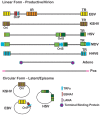Telomeres and viruses: common themes of genome maintenance
- PMID: 23293769
- PMCID: PMC3533235
- DOI: 10.3389/fonc.2012.00201
Telomeres and viruses: common themes of genome maintenance
Abstract
Genome maintenance mechanisms actively suppress genetic instability associated with cancer and aging. Some viruses provoke genetic instability by subverting the host's control of genome maintenance. Viruses have their own specialized strategies for genome maintenance, which can mimic and modify host cell processes. Here, we review some of the common features of genome maintenance utilized by viruses and host chromosomes, with a particular focus on terminal repeat (TR) elements. The TRs of cellular chromosomes, better known as telomeres, have well-established roles in cellular chromosome stability. Cellular telomeres are themselves maintained by viral-like mechanisms, including self-propagation by reverse transcription, recombination, and retrotransposition. Viral TR elements, like cellular telomeres, are essential for viral genome stability and propagation. We review the structure and function of viral repeat elements and discuss how they may share telomere-like structures and genome protection functions. We consider how viral infections modulate telomere regulatory factors for viral repurposing and can alter normal host telomere structure and chromosome stability. Understanding the common strategies of viral and cellular genome maintenance may provide new insights into viral-host interactions and the mechanisms driving genetic instability in cancer.
Keywords: EBV; HHV6; KSHV; MDV; replication; telomere; virus.
Figures



References
-
- Arnoult N., Van Beneden A., Decottignies A. (2012). Telomere length regulates TERRA levels through increased trimethylation of telomeric H3K9 and HP1α. Nat. Struct. Mol. Biol. 19 948–956 - PubMed
-
- Arora R., Brun C. M., Azzalin C. M. (2011). TERRA: long noncoding RNA at eukaryotic telomeres. Prog. Mol. Subcell. Biol. 51 65–94 - PubMed
Grants and funding
LinkOut - more resources
Full Text Sources

